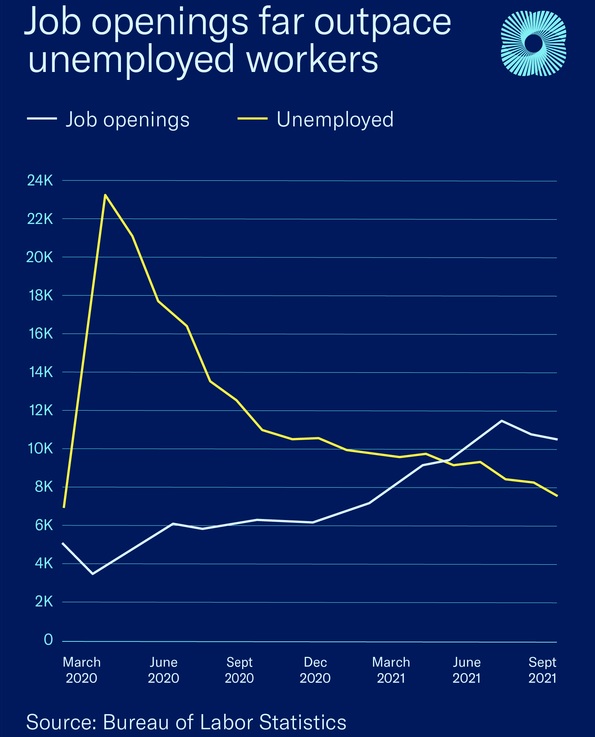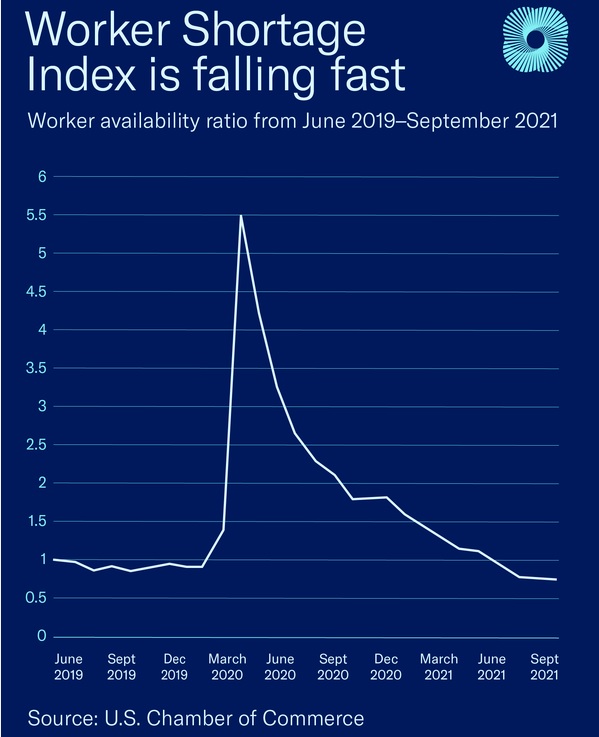The worker shortage crisis continues. The Bureau of Labor Statistics (BLS) reports there were more than 10.4 million job openings in the economy at the end September, only 191,000 less than at the end of August when openings exceeded 10.6 million. In total, businesses have added almost 3.7 million job openings in 2021. Because of the overabundance of job openings, there are now 2.8 million more job openings than there are unemployed workers in the economy.
One Chart That Shows the Job Situation in Every State
How Small Business Owners Feel Right Now About Finding Workers, Vaccine Requirements
Openings continue to be severely elevated above historical norms because job takers are simply not keeping up with openings. The quit rate was 3% in September, which is the highest it has ever been. Workers know that jobs are plentiful and that they can secure another one easily.
New data from the U.S. Chamber shows that more than one in ten unemployed workers have left multiple jobs during the pandemic. Among those currently unemployed who have held multiple jobs since April 2020, 45% held their most recent position for two months or less.
At the same time, the majority (53%) of unemployed workers who lost jobs during the pandemic are not actively job searching. Forty-five percent of workers polled feel that they can remain out of work for six months or more, before it becomes essential to return to a full-time job.
Worker Shortage Index at a Record Low
The Worker Shortage Index compares the number of available workers, defined as the unemployed plus those marginally attached to the labor force, to the number of job openings. When the index is above one, there are more workers than job openings. When it’s below 1, the opposite is true.
In September the Index was 0.87, meaning there were more job openings than available workers. This is a record low and only the fifth time since 2000 the index has slipped below 1. It was 0.88 in August. It is well down from April 2020 when it was 5.5.
Worker Shortage Index
Prior to COVID, the Index was similarly low. It dipped below 1 in August and October of 2019. It was 1.0 in February 2020. But the circumstances in the labor market were remarkably different back then. There were about 7 million openings and available workers then. Today there are much more of each – 10.4 million openings and more than 9 million workers available.
Before the pandemic, the Index was going to be hard to lower much further because of skills and location mismatches between jobs and workers. Those issues still exist, but they are not the abiding problem right now, which is that available workers are hesitant to take the overwhelming abundance of available jobs.
The biggest problem our economy faces right now is getting workers to fill the historically large amount of open jobs. Workers are staying on the sidelines because of fears about the virus, lack of child and dependent care, early retirements, a general shift in preferences for remaining out of the workforce, and other factors.
The enormous number of job openings is holding the economy back from reaching its potential and is threatening what should be a prolonged economic boom.
Disclaimer: Articles featured on Oregon Report are the creation, responsibility and opinion of the authoring individual or organization which is featured at the top of every article.




